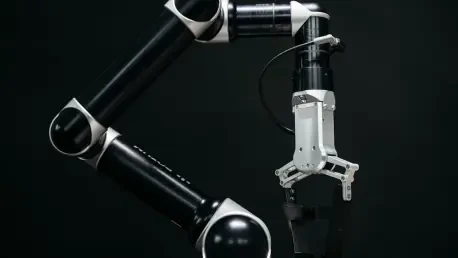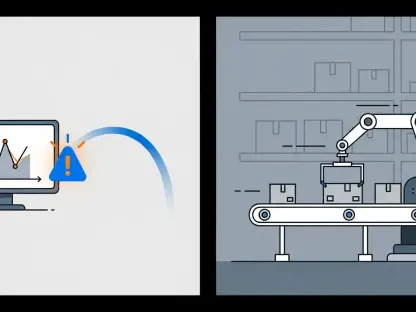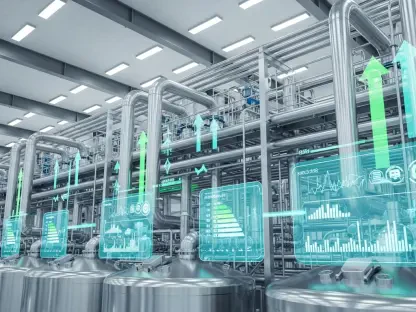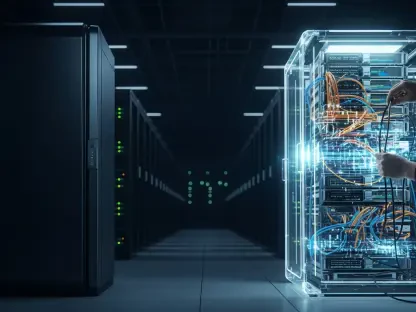The rise of innovative solutions in mechatronics and the Internet of Things (IoT) is fundamentally revolutionizing industries, enhancing efficiency, reducing costs, and minimizing downtime. At the heart of this transformation are real-time sensor analytics and predictive maintenance technologies. These advancements are breaking new ground across sectors such as logistics, healthcare, manufacturing, and oil and gas, establishing unprecedented standards for operational excellence and productivity.
The Power of Real-Time Sensor Analytics
Enhancing Operational Efficiency
Real-time sensor analytics are reshaping how industries operate by providing immediate insights into critical processes. This technology allows businesses to command quick and informed responses to various operational challenges, directly impacting productivity. With sensors feeding constant data, industries can swiftly pinpoint performance bottlenecks, foresee potential system failures, and streamline operations to prevent interruptions. This immediate data flow helps eliminate guesswork, ensuring that operations run smoothly and efficiently. As organizations continue to adopt real-time analytics, they witness noticeable gains in productivity and operational efficiency. The ability to address problems before they escalate into downtime or decreased output is quickly becoming a key differentiator in competitive markets. By using data to inform decisions on the fly, companies position themselves for sustained success, optimizing both their resources and workforce.
This capability plays a crucial role in refining processes and aligning them with strategic goals. In an era where time is synonymous with money, the ability to act swiftly on operational insights ensures that companies maintain operational momentum. Real-time data aggregation allows businesses to respond promptly to market demands, making dynamic adjustments that reflect current conditions and future projections. This agility not only maximizes efficiency but also fosters a culture of continuous improvement, where iterative adjustments lead to better performance over time. The integration of real-time analytics has ushered in a new era of smart decision-making, where data-driven strategies are at the center of organizational growth and innovation.
Strategic Decision Making
Leveraging insights from sensor data empowers organizations to make decisions that align with their strategic objectives while fostering a more agile and responsive business climate. In today’s data-driven world, the power of information lies in its application toward achieving long-term goals. Businesses equipped with real-time data can pivot quickly, adapting strategies to current conditions and emerging opportunities. This adaptive approach allows companies to stay ahead of the competition and seize new market openings. With the informed insight that sensor data provides, decision-makers can chart paths that reduce risks, capitalize on strengths, and address weaknesses proactively. Strategic decisions driven by data are often more precise, targeted, and effective than those based on historical assumptions alone, enabling enterprises to operate with confidence and foresight.
The importance of data-driven decision-making is accentuated in sectors where rapid changes can dictate success or failure. By synthesizing information from various sources, organizations gain a competitive edge, crafting strategies that are robust and forward-thinking. Not only does this enhance immediate operational performance, but it also strengthens long-term organizational resilience. As companies continue to harness the power of real-time analytics, they create an environment where strategic goals are met with operational excellence, paving the way for sustained growth and innovation. By embedding data at the heart of decision-making processes, businesses are not just surviving in competitive industries; they are thriving, armed with the ability to anticipate and respond to change effectively.
Predictive Maintenance: An AI Revolution
Preventing Equipment Failures
Predictive maintenance represents a groundbreaking shift in how companies manage and maintain their equipment, leveraging artificial intelligence (AI) and machine learning technologies to foresee equipment issues before they manifest. This paradigm shift reduces downtime and cuts maintenance expenses significantly. By analyzing patterns and anomalies in equipment data, AI-driven models predict potential failures, enabling companies to schedule necessary repairs during non-peak times. This proactive approach prevents disruptions that can result in substantial financial losses, maintaining uninterrupted operations and ensuring consistent productivity. The capability to predict equipment issues not only saves costs associated with severe breakdowns but also improves the overall reliability of the systems in place.
The implementation of predictive maintenance transforms maintenance from a reactive to a proactive discipline. Regular monitoring and analysis make it possible to address issues before they culminate in costly downtimes, ultimately safeguarding the longevity and efficiency of machinery. Companies can tailor their maintenance strategies to actual needs, rather than relying on predetermined schedules that may not always align with equipment performance. As a result, they optimize resource allocation, focusing energies and funds where they are needed most. This foresight not only ensures operational stability but also maximizes the lifespan of assets, enhancing the return on investment for machinery and technology.
Extending Equipment Lifespan
Predictive maintenance is integral in prolonging the operational life of equipment, thereby realizing substantial cost savings. By anticipating and addressing potential issues before they escalate, businesses ensure equipment functions optimally over extended periods. This proactive maintenance model enables organizations to extend the lifecycle of machinery, reducing the frequency of replacements and the associated costs. Targeting specific areas of concern before they develop into significant problems, predictive maintenance reduces wear and tear and facilitates a maintenance schedule that is aligned with machine conditions. Consequently, this approach ensures sustained machine performance, supporting long-term business objectives through reliable and continuous operations.
The extended lifespan of equipment achieved through predictive maintenance equates to major financial savings and enhanced business reliability. Businesses can preserve their capital by deferring the cost of purchasing replacement equipment, conserving funds for other critical investments. As equipment stays in service longer, companies benefit from sustained operational stability, mitigating the risks associated with unexpected downtimes. This level of confidence enables businesses to promise consistent service delivery to clients, maintain their reputation, and build trust within the marketplace. Predictive maintenance, therefore, stands as one of the pillars of modern industrial strategy, aligning technological advancements with business performance goals to foster sustainable growth and efficiency.
Gaurav Kumar SinhA Visionary in IoT and Mechatronics
Leadership and Strategic Partnerships
Gaurav Kumar Sinha, a leading figure in IoT and mechatronics innovation, exemplifies impactful leadership by advancing the fields of real-time sensor analytics and predictive maintenance. Through his strategic vision and technical expertise, Sinha has introduced groundbreaking solutions that have set new standards across various industries. A core aspect of his approach includes forming strategic partnerships with technology giants like AWS, Microsoft Azure, and Google Cloud. These alliances have significantly enhanced his organization’s technological capabilities and expanded service offerings. By leveraging the strengths of these industry leaders, Sinha’s organization has positioned itself at the forefront of IoT and mechatronics innovation, reflecting the critical role of collaboration in technological advancement.
His strategic partnerships not only boost the organization’s competitive edge but also enhance its ability to innovate and deliver cutting-edge solutions. These collaborations provide access to advanced technologies and platforms that augment the organization’s research and development capabilities. As a result, Sinha’s leadership fosters a culture of continuous innovation and real-world application, consistently pushing the boundaries of what is possible within the domains of IoT and mechatronics. By integrating diverse technologies and expertise, the organization Sinha leads is well-equipped to address complex challenges and deliver superior solutions that drive efficiency and productivity across industries.
Impact Across Various Industries
Sinha’s pioneering innovations have had a profound impact across multiple sectors, revolutionizing how operations are conducted in logistics, healthcare, and manufacturing. Through his expertise in integrating IoT-based systems, Sinha has significantly enhanced efficiency and reduced costs, showcasing tangible outcomes in operational excellence and financial performance. In logistics, his implementation of smart IoT systems has streamlined supply chains by optimizing data analytics. These advancements lead to a more efficient distribution of resources, ultimately lowering operational costs. In healthcare, Sinha’s contributions include the development of IoT-enabled medical devices and platforms that facilitate real-time patient monitoring, improving both care delivery and outcomes. This integration of technology into healthcare practices emphasizes patient safety and operational efficiency.
In the manufacturing sector, Sinha’s innovative systems have resulted in marked improvements in production processes, generating significant annual cost savings. One of his notable achievements involves the creation of a real-time sensor analytics platform that boosted industrial process efficiency by 20%, translating into an annual savings of $2 million. His AI-driven predictive maintenance models have cut maintenance costs by 25% and increased equipment uptime by 15%, saving $3 million annually. These results clearly illustrate the transformative power of Sinha’s innovations and highlight the immense potential of IoT and mechatronics to drive industry-wide changes. By addressing industry-specific challenges with tailored solutions, Sinha continues to redefine the standards of excellence in various operational domains.
Addressing Challenges and Future Prospects
Integrating Technologies and Enhancing Security
Gaurav Kumar Sinha has skillfully navigated numerous challenges in the integration of IoT technologies, particularly in working with legacy systems and enhancing data security. His initiatives have successfully surmounted these obstacles, resulting in marked improvements in operational efficiency and security. The integration of IoT with older systems often poses significant challenges due to incompatibilities and the complexity of existing infrastructures. However, Sinha’s strategic approach has facilitated seamless integration, ensuring that the benefits of IoT technologies can be fully realized without disrupting existing processes. Emphasizing robust security measures, Sinha has not only protected sensitive data but also built trust among stakeholders, reinforcing the security and reliability of IoT applications.
His published works demonstrate a comprehensive understanding of the intricacies involved in IoT, data analytics, and machine learning, showcasing expertise that spans a wide array of applications. By addressing these challenging areas with innovative solutions, Sinha has set a precedent for effectively overcoming integration and security hurdles. His contributions emphasize the importance of developing secure, reliable, and efficient systems that can adapt to changing operational needs. As industries continue to evolve, the approaches and solutions articulated by Sinha serve as valuable models for organizations seeking to harness the power of IoT while ensuring data integrity and robust performance.
Future of IoT and Sustainability
The integration of cutting-edge technologies in mechatronics and the Internet of Things (IoT) is transforming various industries by improving efficiency, lowering expenses, and cutting downtime. Central to this shift are the deployment of real-time sensor analytics and predictive maintenance technologies, which are fundamentally altering how different sectors operate. These innovations are making an impact across industries like logistics, healthcare, manufacturing, and oil and gas, setting new benchmarks for operational performance and efficiency. In logistics, real-time tracking helps optimize routing and reduce fuel costs. In healthcare, IoT devices monitor patient health remotely, ensuring timely interventions. In manufacturing, predictive maintenance anticipates equipment failures, preventing production halts. The oil and gas industry benefits from IoT by monitoring equipment performance, thus avoiding costly shutdowns. Overall, these advancements are pushing industries toward unprecedented productivity and operational excellence, ensuring businesses remain competitive in a rapidly evolving technological landscape.









